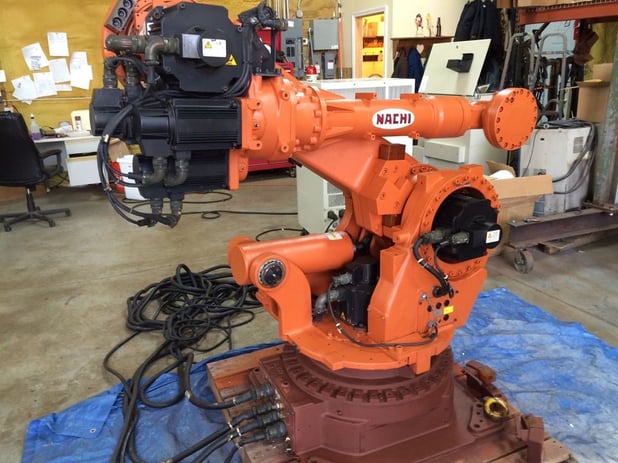Why would a manufacturing firm that took possession of six industrial robots as part of an acquisition deal, send them away to be chopped up for scrap metal after less than three years? Not one of the robots was even powered up.

Why Not?
A little bit of history: the company has an assembly line that includes polishing long, aluminum extrusions. This polishing task is very manual, very very dirty and extremely repetitive. By all definitions, this is a perfect application for an automation solution.
They got six, older, robot arms; the kind that are trained with a pendant. These robots were equipped to do the job and had all the needed polishing tools already on the arms. Yet, the company decided, in the end, not to install any of them for any purpose and instead elected to send all six of the robots to the shredder as scrap metal.
Why, You May Ask, When they Had Robots to Do the Job, Did they Elect to Continue with Human Labour?
In the process of interviewing the CEO, I discovered that there were a lot of reasons, but when I asked him why; lack of talent was his immediate answer. I wanted to know what that meant, so he told me that basically, he couldn’t find the right people with the right knowledge and skills to get the work done.
From his perspective, there is a lack of support for manufacturing firms who would like to explore automation, but have no idea where to start.
Automation Systems Are Complex. Robots Are Many but Robotic Solution Designers Are Few.
When developing an automation solution, it is obvious that a business case needs to be made for each installation. It turned out, after some analysis, the best case for this company was, in fact, not in the polishing line but in the welding line.
For their product, a steel box is needed. It took a long straight weld to complete the box, but later in the assembly, the weld is ground off. Engineers looked at the design and realized that the process was not efficient considering that the weld was removed later. It was a bad process. By automating the solution, they would only be automating a bad process. The process was reviewed, reworked and redeployed to reduce the welding requirement by 95 percent. A robotic solution no longer held any return on investment.
They could still be used for polishing, though. The robots polished aluminum on the other company’s assembly line. But the acquisition did not include the building. So the robots had to be unbolted and shipped to their new location. This meant that the robot work cells would need to be built in the new location. Now you can start to add some dollars to the project and not just a few of them.
With pendant learning industrial robots, basically, the robot is walked through the process, step by step and then during operation, simply repeat those steps. These were pretty advanced robots, in their day, but these kinds of systems are being eclipsed by today’s every evolving technology.
These robots have no artificial intelligence and no vision systems for helping with things like alignment. Jigs for these robots need to have tolerances within three thousandths of an inch. If an extrusion shifts in its jig, the polishing job will not be even and it will have to be done again, so setting up this kind of robot can be quite picky.
In the end, though, it was the safety issues that were the real show stopper. These old robots had no sensors to guard against accidental contact with human workers and would need to be retrofitted with the latest in safety technology to meet Health and Workplace Safety requirements. Work cells had to be designed, built and barriers would need to be installed with signage, warning systems and intrusion detection.
All the fail-safe systems required by government, to prevent humans from being injured or killed by robots add thousands of dollars to an installation. Good insurance? Of course, but the upgrades were worth more than the robot!
So in the end, the deciding factor was the necessary retrofitting of the safety systems. The cost of the risk assessment, the cell construction and compliance with Health and Safety rules combined with the required retrofitting was cost prohibitive and since the used robot market is poor for outdated robots, they were basically useless. The decision was made just to scrap them.
This solution is an excellent example of what makes collaborative robotics so excellent. Collaborative robots or cobots have built-in systems to detect impact if they occur, others have sensors that allow the cobot to track the presence of humans in the work area and slow down or stop if a risk of collision exists.
In addition, the cobot is usually smaller than older industrial robots, so their lower mass reduces the potential for serious injury, but if the cobot does touch you, it can tell it hit something and instantly goes into Protected Stop Mode.
It is exciting to live at a time when these rapidly emerging technologies keep opening new doors. This is a time when cobots will be handing parts to humans and taking them back to place on pallets or conveyors. Gone will be the mundane. Gone will be the heavy, dangerous robots of yesterday.
Tomorrow’s promise is that we will have efficient and cost effective integrations.










Leave a comment